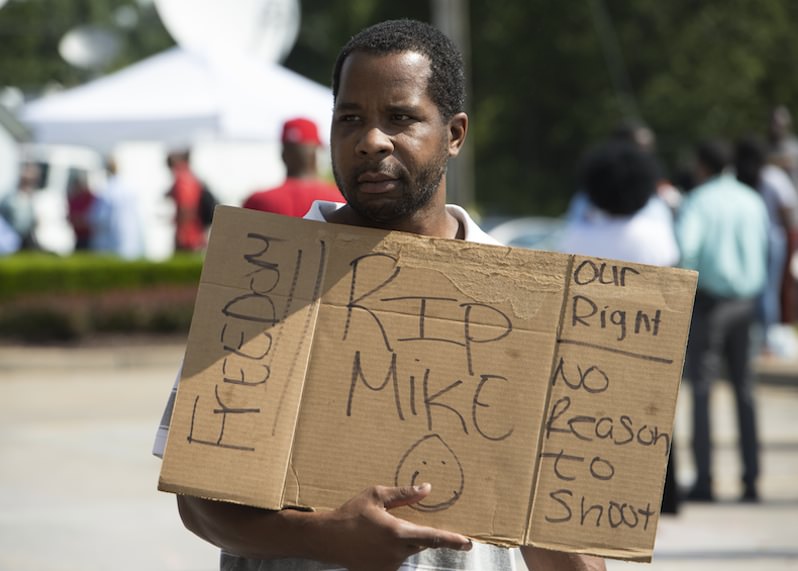Ferguson’s Next Rally: Justice for Michael Brown
The real pressure point now moves to the grand jury of St. Louis County. The focus should now be justice for Michael Brown. Shutterstock
Shutterstock
When I first heard the reports of an unarmed 18-year-old black youth shot and killed in Ferguson, Mo., while, according to witnesses, surrendering to the police, my heart dropped.
Immediately my thoughts went to the tall, strong, handsome sons, nephews and cousins that populate my extended family from Los Angeles to Long Island. My thoughts were of concern for their safety in every innocent moment of their lives, as I was reminded again that innocence is not sufficient to ward off the unwarranted attention of the police.
In the instant I heard the reports, I was reminded that others see those very same sons and nephews not as tall, but as imposing; not as strong, but as dangerous; not as handsome, but as menacing. Once again I was reminded of the layer of fear and anxiety that lies heavy on every black family in America.
This layer of concern is one with which white families are not familiar. When I heard the reports, it served as yet another stark reminder that though blacks and whites physically live side by side, we live in two different countries: black America and white America.
The tragedy unfolding in Ferguson is made all the more sad by the cynical actions of the city’s police chief, Thomas Jackson, and all those involved in a possible cover-up of Officer Darren Wilson’s shooting of Michael Brown. From the day of the shooting, the police department has known Wilson’s account of what happened on Canfield Street, but it revealed only the part that involved the struggle at the police car and the first shot.
The frustration of the community has been palpable and begs for a full accounting of why this young man was shot to death for what appears to be the crime of jaywalking. Jackson stated at a news conference, with a straight face, that Brown was engaged by Wilson for “blocking traffic.” The only traffic it seems he was blocking was the police car Wilson was driving.
Although none of the video shot by camera phones on the scene captured the actual shooting, we still felt the same kind of frustration that we had in 1991 when Los Angeles Police Department officers were caught on tape beating Rodney King — that without these eyewitnesses and their video we might never know the true circumstances of Brown’s death.
Then, just when calm seemed to be settling in, the police chief convened another news conference to release a video of his own, an alleged incident of “strong-arm robbery” committed by someone resembling Brown.
Predictably, the Ferguson community exploded in rage and resistance at the undisguised attempt to smear the character of the shooting victim. The Justice Department had warned Jackson that releasing the photographs and video of the convenience store incident would serve only to inflame the situation. It almost seemed as if the chief intended to provoke a community reaction that would further distract from the issue of Wilson’s culpability and focus on the violence of some protesters as an extension of the violence officers wanted to claim was natural to Brown.
The police have been withholding information that would reveal the truth of what happened and have released and leaked only what would bolster Wilson’s defense. This selective dispersal of information confirms the worst suspicions of the black community, that the Ferguson Police Department has no interest in an objective investigation but is determined to exonerate its officer at all costs.
The transcript of the interview with Wilson, certain autopsy reports, official witness statements and forensic evidence have not been made public, although a grand jury began to look at the case Wednesday. The toxicology report on the victim has been leaked. And we are in the ironic position of being grateful that on Aug. 15, a local talk radio station caller who identified herself as a friend of Wilson’s finally alleviated our tortured imaginations by offering an account of the shooting from the perspective of the officer. At the same time, we are mindful that this version was provided only after the results of the family-sponsored postmortem examination were released, perhaps so that the caller’s narrative could conform with that autopsy’s findings.
However, a few facts are clear. Wilson initiated a confrontation with Brown with flimsy probable cause. He did not know anything yet about the incident at the convenience store. All he seems to have known at the time was that a young black man was walking in the street in front of his police car and did not show sufficient deference to his presence. Wilson’s order that Brown relocate to the sidewalk was ignored, and a physical confrontation ensued.
The officer’s apparent incompetence allowed a teenager to gain the upper hand in this confrontation to the extent that, according to some accounts, the officer pulled and fired his gun from within his police cruiser. Startled by the gunshot, Brown reportedly ran away from the cruiser. Apparently, Wilson, instead of waiting for backup, inexplicably exited the cruiser, pursuing Brown while supposedly firing wildly, missing his target but striking a home in the neighborhood. Then, as the fleeing Brown is said to have stopped his flight and turned around with his arms raised, the pursuing officer reportedly continued to shoot until Brown was dead.
Seemingly every witness on the scene who has spoken publicly has said that Brown was surrendering when the officer shot him to death. The family’s autopsy report shows that the final, fatal shot entered the top of Brown’s head and sliced through his brain. This most likely happened as he was falling face forward to the ground after being struck by at least five other bullets.A thirdhand account of Wilson’s version argues that the shot in the head occurred when the 6’4” Brown was bent over while charging Wilson. Rather than risk being overcome by the teenager, Wilson, said to be in fear of his life, opened fire on the advancing Brown.
There seemed to have been a number of opportunities for Wilson to defuse, delay and prevent this deadly confrontation. His training should have directed him to wait for his partner to arrive before he encountered the jaywalker who was “blocking” traffic. A more competent officer would have relied on nonlethal options like pepper spray to stall an unarmed charging opponent whom he or she could not physically subdue.
So we are left with a seemingly subpar officer with an injured ego who overreacts to the taunts of a teenager, the deadly result of which has brought a community to the degree of violence and frustration that we have witnessed these past two weeks. The Ferguson Police Department officers want the public to focus on an intoxicated, unruly, strong-arm robbing teenager rather than the excessive and deadly force of one of their officers. They know this public relations chaff will blunt the criticism of Wilson’s behavior.
But they should be wrong. Civil rights are best tested when the test involves the worst citizen, not the best. When we give lethal power to police officers, we expect them to exercise the highest levels of patience, tolerance and restraint. Wilson failed this test, and that is not just what matters most — it is the only thing that matters. Brown deserved to go home — with a jaywalking ticket, but he did deserve to go home.
Community leaders and their organizations have an important role to play in this situation. Theirs is the role of organizers of the legitimate grievances of the public, a constant vigil of witness for justice for Brown and as vehicles for institutionalizing the changes that will lead to a better quality of life for their constituents. Hopefully the leadership in Ferguson will find a clear path into which to channel the energy of the community that will highlight its demands for justice.
The real pressure point now moves to the grand jury of St. Louis County. The protests should shift to the Buzz Westfall Justice Center in Clayton, Mo., where that panel is meeting, and away from the few blocks in Ferguson that have kept the spotlight on the killing. The focus should now be justice for Brown.
Moving to the courthouse will accomplish two important goals: First, it will remove the cover that looters have exploited to engage in criminal activity. The looters are unlikely to travel 12 miles to Clayton to rob and firebomb convenience stores. Second, it will move the protests to the corresponding point in the process. It was right to begin the demonstrations at the scene of the crime to let the world know what happened there. It was right to then move to the Ferguson police headquarters where the possible cover-up was being perpetrated. And now it is right to move to the courthouse to bring the focus to the criminal justice system. The protests should stay there until a decision to indict is made.
This is not just about Ferguson. This is about America. Every black person will tell you that this could happen anytime, anywhere. It will be a long time before we root out every racist officer in the police departments of this country. But what we do expect from the institutions that police the police is cleareyed justice that will not blink when an officer has slain an unarmed black teenager.
The arrival of Attorney General Eric Holder in Ferguson was a sign of the progress we have made as a nation. I cannot imagine George W. Bush-appointed Attorney General John Ashcroft coming to see about a dead black youth. So let the looting stop, but let the protests proceed until justice is finally done for Michael Brown.
Show your support for Truthdig’s independent journalism and donate today.
Rev. Shockley: Support Bringing Truth to a Post-Truth Era from Truthdig on Vimeo.
Your support matters…Independent journalism is under threat and overshadowed by heavily funded mainstream media.
You can help level the playing field. Become a member.
Your tax-deductible contribution keeps us digging beneath the headlines to give you thought-provoking, investigative reporting and analysis that unearths what's really happening- without compromise.
Give today to support our courageous, independent journalists.









You need to be a supporter to comment.
There are currently no responses to this article.
Be the first to respond.